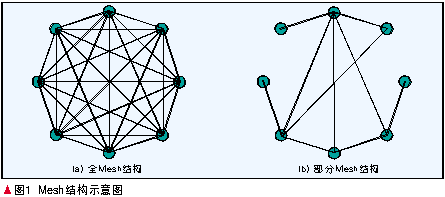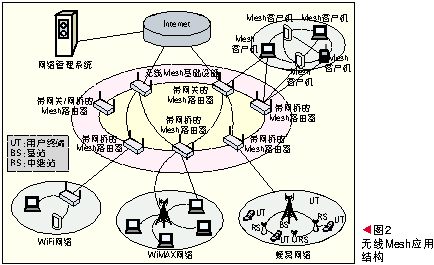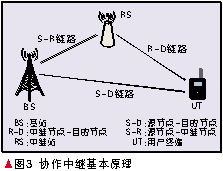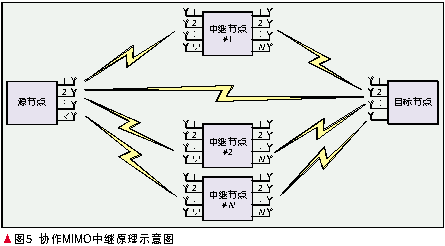Wireless mesh network and cooperative relay technology
Abstract: Wireless mesh networks have become a research hotspot in the field of wireless broadband communications, but wireless mesh networks based on switching technology cannot be applied to large-scale coverage because they view the entire network as an IP subnet. Using cooperative relay in the wireless link can improve the transmission rate and reliability of the wireless link. At the same time, the wireless mesh technology based on the network layer routing technology can be used to improve the spectrum efficiency and wide area coverage of the entire wireless mesh network. However, due to many problems in standardization, key technology research and industrialization promotion, the application of cooperative relay technology in wireless mesh networks is facing huge challenges.
Keywords: wireless mesh network; cooperative relay; wireless mesh structure; routing technology
Abstract: WirelessMeshnetworkshave become a focus in research of wireless broadband communicaTIons. In a switching technologies-based wireless Mesh network, the enTIre network is regarded as an IP subnet, so it cannot be applied in situaTIons where large coverage is required. The use of cooperaTIve relaying technologies can improve the transmission rate and reliability of wireless link; while the wireless Mesh network, once integrated with cooperative relaying technologies and routing technologies, can improve its spectrum efficiency and cover a wide area. However, there are many problems to be solved with respect to standardization, key technologies research and industrialization. Therefore, the application of cooperative relaying technologies in wireless Mesh networks is still a great challenge.
Keywords: wirelessMeshnetwork; cooperative relaying; wireless Mesh architecture; routing technology
The wireless mesh network is the product of the integration of mobile Ad hoc networks and cellular networks, and is a multi-hop Ad hoc network. Unlike mobile Ad hoc networks, which implement peer-to-peer communication between user mobile devices, wireless mesh networks mainly provide wireless access for user terminals [1-7]. The wireless mesh network has the characteristics of self-organizing network, self-management, automatic repair, self-balancing, node self-management, and multi-hop. It has simple installation and wide coverage, can dynamically realize mobile broadband access, support multiple services, and wireless positioning Etc., so it has gradually become a research hotspot for broadband wireless access. The IEEE standardization organization is also working with industry and academia to work on the standardization of wireless mesh networks, such as IEEE 802.11s, IEEE 802.16j, IEEE 802.15.5, IEEE 802.20, and IEEE 802.16m [8].
1 Technical characteristics of wireless mesh network
1.1 Classification of wireless mesh networks
In the open system interconnection (OSI) network layering model, the second layer is the data link layer, and the third layer is the network layer. At present, wireless mesh networks can be technically divided into two categories: one is the wireless mesh network of Layer 2 or the wireless mesh network using switching technology, and the other is the wireless mesh network of Layer 3, or It is a wireless mesh network based on routing technology [9].
From the perspective of TCP / IP, the wireless mesh network based on Layer 2 treats the entire wireless mesh network as an IP subnet. The wireless mesh network technology of IEEE 802 series and the vast majority of wireless mesh network products currently on the market fall into this category. Complete access control, mesh networking, routing, link congestion control, fast movement, handover support, and security authentication in Layer 2 of the network. At present, most manufacturers' products are wireless mesh networks solved by switching technology, that is, Layer 2 performs data exchange between access points (AP). For the coverage of small-scale networks, this wireless mesh based on Layer 2 can also be competent.
Unlike the wireless mesh network based on Layer 2, the wireless mesh network based on Layer 3 allows the entire wireless mesh network to be divided into multiple IP subnets, and the communication between the IP subnets is achieved through IP routing. Because of the routing-based technology, when the data of node A is transmitted to node B, there is no need to exchange data with the root node, but take the shortest path to reach node B. The wireless mesh network with routing capability has a structure similar to a wired network. The router in each wireless network not only provides Internet access for users connected in the coverage area, but also serves as the basic facility of the network to route data through the wireless mesh network. To the destination. The mesh network that supports routing has the characteristics of high flexibility and strong fault tolerance. It simplifies the line-of-sight communication problem and expands the coverage of the network with the minimum amount of network infrastructure and interconnection costs.
1.2 The basis of wireless mesh network implementation
Whether it is a wireless mesh network based on Layer 2 or a wireless mesh network based on Layer 3, it is essentially a multi-hop network with two adjacent nodes (which can be regarded as a source node and a destination node). The quality, reliability and efficiency of inter-communication are the basis for ensuring the excellent performance of wireless mesh networks. The cooperative relay technology can make full use of the information of the multi-hop path from the source node to the destination node, and thus can improve the performance of the wireless link between the source node and the destination node, thereby satisfying the communication between the two nodes of the wireless mesh network Quality requirements.
Due to the mobility of mesh nodes, the network topology is constantly changing, and traditional Internet routing protocols cannot adapt to these characteristics. Therefore, it is necessary to develop special routing protocols, and at the same time, it is necessary to ensure the data rate and transmission between the two nodes at the physical layer. reliability.
In addition, for wireless mesh networks, it is not only possible to consider the improvement of protocol performance at a certain level. It is necessary to consider the impact of multiple levels at the same time and conduct cross-layer design. That is, to break the strict layered constraints in the traditional open system interconnection reference model (OSI / RM), for the different states and requirements of the relevant modules / protocols of each layer, use the interdependence and influence between layers to affect network performance Perform overall optimization. Specifically, cross-layer design is to make full and reasonable use of existing network resources to achieve the ultimate goal of maximizing total system throughput, minimizing total transmission power, and QoS optimization.
2 Combination of wireless mesh network and cooperative relay technology
2.1 Backbone network needs to implement wireless Mesh structure
The wireless mesh network is a wireless network technology based on the IP protocol. In terms of network topology, the wireless mesh network can be regarded as a wireless version or a miniature version of the Internet. With the development of broadband wireless technology, people need wireless networks with higher data rates, higher spectrum efficiency, higher coverage, and stronger business support capabilities. For example, B3G / 4G requires a transmission rate of 1 Gb / s. The frequency spectrum is at least 100 MHz. For such broadband spectrum requirements, it is difficult to find in existing frequency bands, so B3G / 4G needs to be allocated a higher frequency band, such as 5 GHz or 6 GHz.
The increase in operating frequency and the increase in bandwidth are conducive to the increase in data rate. However, the increase in frequency will lead to a reduction in the coverage of the cell, which in turn will cause a contradiction between the data rate and the coverage. Make a compromise. For example, IEEE 802.11n expects that within 15 m, the media access control (MAC) layer data rate will reach 100 Mb / s; ultra-wideband (UWB) can provide data rates up to 480 Mb / s, but its coverage can only be To reach 2 m or lower. In this case, to achieve a high data rate in a large coverage area, a large number of APs need to be deployed in the future wireless network. However, it is difficult to install a large number of APs in reality. On the one hand, the construction cost is too high. On the other hand, it is also unrealistic to connect all wireless APs to the wired backbone network, especially in those currently without wired services. Region. Although the structure based on Mesh and relay is a more feasible solution, and many wireless mesh network products currently on the market can be connected with wireless personal area network (WPAN), wireless metropolitan area network (WMAN), wireless LAN (WLAN) and wireless broadband access (WBA) systems, but if the entire wireless Mesh network is regarded as an ocean, these WPAN, WMAN, WLAN and WBA are like "isolated islands" in the ocean. They Only when the central controller is connected to the backbone network can it provide real services to users. Therefore, from this perspective, to achieve wireless mesh coverage of the entire network, the first thing to be solved is the wireless implementation of the backbone network itself [10].
2.2 Structure of wireless mesh network
A wireless mesh network is a full wireless network that uses multiple hops, and data flows into and out of the wired Internet gateway. Compared with the flat Ad hoc, the wireless mesh network presents a hierarchical feature, and its nodes can be divided into Mesh routers and Mesh clients according to their functions. These Mesh nodes can form a full Mesh structure or a partial Mesh structure. The so-called full mesh structure means that any two nodes in the network can be directly connected, while the partial mesh structure means that only some nodes in the entire network can communicate directly. As shown in Figure 1.

Mesh router not only has the function of routing, it also has the function of gateway or bridge. Compared with traditional wireless routers, wireless Mesh routers can achieve the same coverage with a smaller transmission power through a multi-hop network; by strengthening the MAC protocol in the Mesh router, it can also be constructed in a multi-hop Mesh network environment Has better scalability. Mesh client must have the function of networking, at the same time it can also be used as a router. However, in the Mesh client, there is no concept of gateway and bridge, and a Mesh client has only one wireless interface, and can only support one wireless access technology.
At present, two basic wireless Mesh structures can be formed by Mesh routers and Mesh clients, infrastructure wireless mesh and client mesh. However, the more promising is the hybrid structure of the two shown in Figure 2. This wireless mesh network is a combination of infrastructure structure and client structure. Clients can access the network through Mesh routers, and can also directly form Mesh networks with other Mesh clients.

2.3 Features of cooperative relay technology
Cooperative relay is also called cooperative diversity, and its principle comes from the idea of ​​"virtual antenna array". Cooperative relay is an extension of single-path relay. One or more nodes with a common coverage area can be introduced between the source node S and the destination node D to act as the relay node R. The destination node can be merged from the source node and the source node. Following the data of the node. This can alleviate the pressure that the terminal cannot configure more antennas [11]. Taking Figure 3 as an example, the source node, the relay node, and the destination node are respectively served by a base station (BS), a relay station (RS), and a user terminal (UT).

According to the different transmission and reception time slots between each node, the definition "X → Y" means X transmission and Y reception, and cooperative relays can be divided into three categories shown in Table 1. The destination node combines the signals received in different time slots to obtain spatial diversity gain. Because the destination node uses the signal information of multiple paths, it can obtain spatial diversity gain, which in turn guarantees the data rate and reliability of the relay link.

2.4 Combination of wireless mesh domain cooperative relay technology
As can be seen from the foregoing, the wireless mesh network mainly implements the Mesh structure at the network layer or the data link layer. However, the idea of ​​cooperative relay is mainly reflected at the physical layer to ensure the transmission data rate and reliability of the wireless relay link . The following uses the fixed wireless Mesh network shown in Figure 4 as an example to introduce the application of cooperative relay in a wireless mesh network [12]. Among them, the Mesh node includes AP, fixed / or nomadic RS, and the UT does not need to be included in the Mesh structure, but it needs to be connected with the Mesh node in the Mesh structure to accept network services. The AP can be served by the BS or RS, and can be directly connected to the backbone network (generally the Internet). As shown in Figure 4, Node C can combine the signals from Nodes A and B to achieve cooperative relaying and obtain spatial diversity gain.

In any wireless relay link, cooperative relay can be used. In addition, in order to make full use of spectrum resources and multiple input multiple output (MIMO) technology, multiple antennas can be configured in the source node, the relay node and the destination node, and the cooperation of different RSs can be fully utilized to realize cooperative MIMO relay at the destination node. Greatly improve the data rate of the wireless relay link. The basic principle is shown in Figure 5. The simulated transmission rate is about 2 times higher than conventional MIMO. With the development of wireless technology, the use of cooperative MIMO relay technology in wireless mesh networks is bound to be a development direction [13].

3 The main problems faced by the application of cooperative relay in wireless mesh networks
3.1 Standardization issues
The development route of the wireless mesh network itself is that the market occupies first, and the standard advances later. To truly implement carrier-grade applications, the wireless mesh network itself needs to overcome three obstacles: one is the key technology of wireless mesh networking; the second is to overcome the deterioration of network performance caused by the rapid movement of nodes, especially the key to the physical layer Performance; Third, the standardization necessary for the integration of various wireless mesh technologies.
At present, academic circles have conducted in-depth research on cooperative relays, and some research conclusions in standards organizations such as IEEE 802.16j have been conducted, but they are basically carried out on the basis of cellular networks. There is still a long way to go before integrating it into a wireless mesh network and fully standardizing it.
3.2 Key technical research issues
As with conventional relay technologies, the performance of cooperative relay stations is also mainly affected by key processes such as resource allocation, selection of cooperative relay nodes (or cooperative route discovery and maintenance), delay, and handover. From an implementation point of view, the following aspects need to be studied in depth:
Cooperative relay station selection and resource allocation: These two processes are closely related, especially in an orthogonal frequency division multiplexing multiple access (OFDMA) system, the two need to be carried out jointly, the key is the signaling load is low.
Transmission delay: The increase in the number of hops leads to a larger delay in the transmission of wireless mesh links, which is a key technology that hinders its large-scale application.
Relay link rate adjustment: For fixed wireless Mesh, many nodes are in line-of-sight (LOS) transmission environment, the source node and the relay node are in the LOS environment, and the relay node and the destination node are in In a non-line-of-sight (NLOS) environment, the conventional MIMO technology cannot be directly used in the LOS situation, which requires a way to coordinate the transmission rate of the relay link, thereby improving the performance of the entire link.
Discovery and maintenance protocol for relay routes: This problem also applies to conventional relay systems, especially the maintenance protocol for relay routes when the UT moves.
3.3 The problem of industrialization promotion
At present, wireless mesh products are mainly from small companies. In addition to Nortel's relatively complete wireless mesh product solutions, there are no other powerful products. Therefore, in order to achieve carrier-class applications for wireless mesh networks, strong support from industry is also required. Only after technologies such as wireless mesh networks are fully used, technologies such as cooperative relays can be vigorously developed.
4 Conclusion
As a new form of network, wireless mesh based on multi-hop, although there are still many key issues that have not been solved, but because of its flexible networking, easy maintenance, large coverage, low investment cost, low risk, and reliable The advantages such as high sex will surely have a broad development space in the broadband wireless access system. And in the development of wireless mesh networks, technologies such as cooperative relays will also play an important role in improving the performance of their links.
5 References
[1] Hossaine, Leung k k. Wireless mesh networks: Architectures and protocols [M]. Berlin, Germany: Springer, 2007.
[2] Schultzdc, Walke b, Hiertz gr, et al. Meshing for relay based deployment concepts [R]. WWRF-WG4 White Paper, 2006.
[3] AkyildizIf, Wang Xudong, Wang Weilin. Wireless mesh networks: a survey [J]. Computer Networks, 2005, 47 (4): 445-487.
[4] Jainr.Wireless mesh and multi-hop relay hop relay networks [R] // Saint Louis, MO, USA: Washington University in Saint Louis, 2006.
[5] LanKc, Wang, Berriman R, et al. Implementation of a wireless mesh network testbed for traffic control [C] // Proceedings of 16th IEEE International Conference on Computer, Communicauions and Networks (ICCCN'07), Aug 16, 2007 , Honolulu, HI, USA. 2007: 1022-1027.
[6] DECPaschoalino r, Madeira er m. A Scalable Link Quality Routing Protocol for Multi-radio Wireless Mesh Networks [C] // Proceedings of 16th IEEE International Conference on Computer, Communications and Networks (ICCCN'07), Aug 16, 2007 , Honolulu, HI, USA. 2007: 1053-1058.
[7] Zhang Yong, Guo Da. Principle and technology of wireless mesh network [M]. Beijing: Electronic Industry Press. 2007.7.
[8] IEEEC802.16m-07 / 076r2 [S]. Draft IEEE 802.16m requirement [M]. TGm Requirements drafting group, 2007-03-13.
[9] Wireless mesh network [EB / OR] .http: //hi.baidu.com/.
[10] HorakR. Webster's new world telecom dictionary [M]. New York, NY, USA: John Wiley & Sons, 2007.
[11] IST-4-027756WINNERII D3.5.1. Relaying Concepts and supporting actions in the context of CGs [S], October 2006.
[12] ZhaoZhipeng, Belfiore j c. Application of Cooperative Diversity in 802.11a Ad-hoc Networks [C] // Proceedings of 16th IEEE International Conference on Computer, Communications and Networks (ICCCN'07), Aug 16, 2007, Honolulu, HI, USA, 2007: 1016-1021.
[13] Sakaguchik. Fumie o. Multiple Access Interference Cancellation and Link Multiplexing for MIMO Mesh Network [C] // Proceedings of 16th IEEE International Conference on Computer, Communications and Networks (ICCCN'07), Aug 16, 2007, Honolulu, HI , USA. 2007: 1028-1033.
About the Author:
Jiang Xiaokui, Ph.D. graduated from the Northwestern Polytechnical University Institute of Acoustics in 2004. Currently he is the third-level chief engineer of the wireless pre-research department of ZTE Corporation. He is mainly engaged in the pre-research and standard work of wireless relay technology and applied for more than 20 related patents.
When people search gaming laptop, indicates that they need high performance 15 Inch Gaming Laptop, comes with big screen size, high cpu, large memory and storage, high resolution display, quality bigger 12000mAh battery, 2MP Camera, etc. 15 or 14 inch 500 Dollar Gaming Laptop, 10th generation laptop, 11th gen gaming laptop, 12th generation laptop, Laptop Intel Core I7, Intel I5 Laptop are the Top 10 Gaming Laptops. Every gamer want to buy Gaming Laptop with higher processors, big 8GB, 12GB, 16GB system memory ram, large Solid State Drive so that can handle or storage digital data at a high speed, 1920*1080 Full HD Slimmer screen provides user stunning vivid visuals, fingerprint reader, backlight keyboard, etc.
Nowadays 11th Laptop is the most competitive cpu, cause performance is better than 10th, but price is nearly same; besides, Solid State Drive cost 512GB is the most welcome and competitive one.
Of course, You can also contact us directly and share your exact requirements, so that we can send the right and valuable information quickly.
Gaming Laptop,Top 10 Gaming Laptops,500 Dollar Gaming Laptop,15 Inch Gaming Laptop,Buy Gaming Laptop
Henan Shuyi Electronics Co., Ltd. , https://www.shuyitablet.com